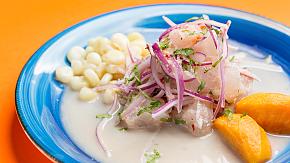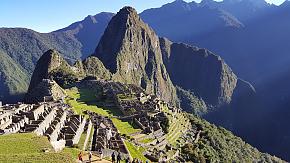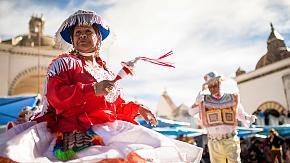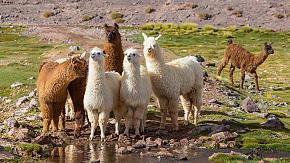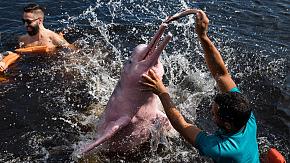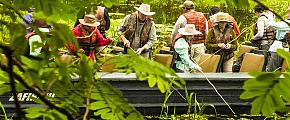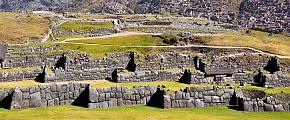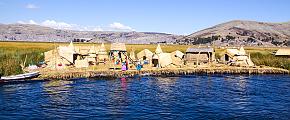Guide to Peru Food: History, Where & How to Try Cuisine
When we talk about Peru, we often think of Machu Picchu. However, it offers much more than just iconic sights: Peruvian food is world-famous. It's been the winner of the World's Leading Culinary Destination awarded by the World Travel Awards for seven consecutive years, the only country to win the prize since the awards began in 2012.
Here I've picked some of the best cuisine you surely can't miss on your Peru trip, while you'll also know where to try it, its different ingredients and flavors, food festivals, and cooking classes.
What Are Traditional Peruvian Food & Where to Try
There is a wealth of fine restaurants in the country, especially in the capital city Lima, providing some of the world's most amazing dining scenes. Some of these restaurants are among the best in the world. Now let's know the Peruvian food and where you can try it.
Ceviche
A perfect example of fusion food (with indigenous, Hispanic, and Japanese culinary influences), this cool lime-marinated fish is no doubt the most famous Peruvian cuisine. Taking full advantage of Peru's rich source of seafood brought by the cold Humboldt Current, Peruvian cooks marinade fresh seafood like sea bass, tuna, octopus, and sea urchin in lime juice. The acid in the juice slowly "cooks" the fish, resulting in a delicate flavor. The marinated fish is usually spiced with red onion and aji pepper and served with a wedge of boiled corn and sweet potato. The best way to eat ceviche is to use a spoon as it allows you to keep all the lime marinade in each spoonful of ceviche so that you can get the full flavor of the dish.
Although it is going global, this delicious dish is best enjoyed in its home country as it is rarely exported with authenticity because it requires a special lime that has the perfect acidity. It must lose some of its meaning if tried somewhere else.
Where to Try Ceviche: This flagship dish is available everywhere in the country from street carts to fancy restaurants, but the best city to find the most delicious ceviche is Lima. There are many amazing cevicherías (ceviche restaurants) in this culinary capital. If you are traveling on a budget and still want to try quality ceviche, head to Mercado de Surquillo where you'll find colorful stalls that offer cheap and cheerful ceviche. Eat ceviche in the morning or afternoon when it's freshest just like the Peruvians do.
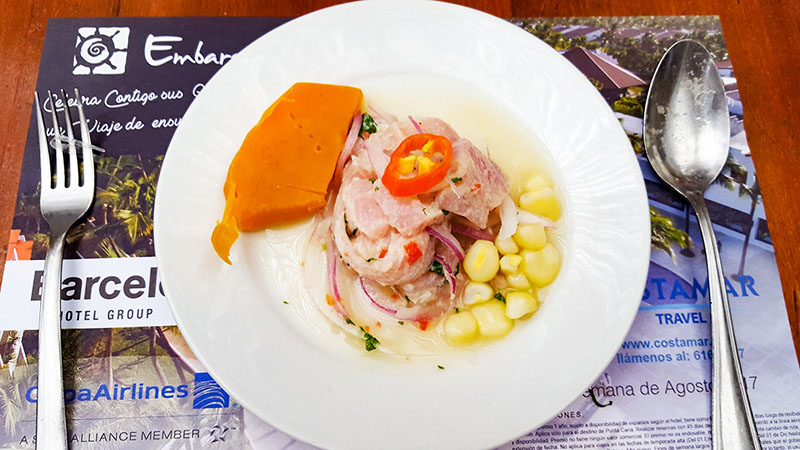 Ceviche, the National Dish of Peru
Ceviche, the National Dish of Peru
Lomo saltado (Stir-fried Beef)
Lomo saltado is a classic Chinese-Peruvian food, which is called chifa in Peru. The name literally means "jumped loin", with "lomo" referring to the cut of meat, and "saltado" referring to the cooking technique stir-frying which involves making the ingredients jump around the wok.
The Chinese immigrants who arrived in Peru in the late 19th century created this unique style of cuisine using the cooking techniques such as stir-frying they brought from China and the locally available ingredients.
Strips of soy-marinated beef, onions, tomatoes, aji peppers and other spices are stir-fried properly in a wok. It's then served with steamed rice and French fries, making a hearty meal with different colors, tastes, textures, and flavors.
Where to Eat Lomo Saltado: Lomo saltado is such a popular Peruvian cuisine that you can find it on most menus in Peru.
Cuy (Guinea Pig)
Neither pigs nor from Guinea, guinea pigs are native to the Andean highlands of South America where they are called cuy (pronounced "kwee") and were domesticated in Peru as far back as 2500 B.C. according to archeologists.
The meat, stuffed with herbs, is usually baked or barbecued on a spit and served whole with the head on. It has spicy, crispy skin and pleasant gamey meat that tastes like rabbit or wild fowl. It's low in fat and cholesterol and higher in protein than chicken, pork, or beef. To eat cuy, simply use your hands just like eating a chicken drumstick. It will be easier to maneuver the tiny bones with your hands.
In the Western world, these little furry rodents are commonly regarded as pocket pets, but in Peru, they are an important source of nutritious food for the indigenous communities of the Andes and have been so for thousands of years, long before they were introduced to Europe and the United States and raised as pets. Guinea pigs were once only eaten on special occasions for ceremonial meals and religious festivals. Folk doctors also used them to diagnose disease. To better understand the importance of cuy in the Peruvian diet, visit Cusco Cathedral. There you can find a replica of Da Vinci's Last Supper that shows Christ and the twelve disciples are dining on cuy.
Where to Try Cuy: Cuy is can be easily found in many restaurants in the Cusco region.
Pachamanca
What do you eat on celebrations? Perhaps cake, turkey, etc. But for the Peruvians, it's all about pachamanca, which is a Quechua word (the language of the indigenous people of Peru) for earth pot.
It is an ancient dish that dates back to the Incas Empire (1438–1533). The preparation of pachamanca has a ritual element. More than just preparing a meal, it's a celebration of life, the food giving fertility and rejuvenation. The Incas believed cooking food underground pays respect to pachamanca, the Incan "Mother Earth" because the food was returned to the earth before being eaten.
Marinated meat (lamb, mutton, guinea pig, alpaca, etc.), potatoes, and corn are cooked in a big hole dug underground with the aid of heated stones for several hours. The result is a satisfying big meal that can serve up to dozens of people, perfect for a highly social experience, bringing people to enjoy good food together. The meat is a little charred on the outside but moist on the inside and the vegetables are moist and smoky.
Where to Try Pachamanca: You can find upscale versions of pachamanca at restaurants in Lima. But I highly recommend you try it in the restaurants in Cusco and Sacred Valley for the best experience.
Tiradito
Similar to ceviche, tiradito is also a dish of raw fish. Unlike ceviche, tiradito is fish sliced into thin strips like sashimi (while ceviche consists of cubes of fish) and simply doused with a piquant salsa made from citrus juice and Peruvian yellow pepper before being served (while ceviche is lightly marinated beforehand). The dish is usually garnished with sweet potato and boiled corn.
Lightly marinated, cubed, raw fish could be found in Peru in the 16th century when Spaniards brought lemons. Before that, the Incas marinated fish in salt and fermented corn. The Japanese immigrants who arrived in the 19th century turned the dish into an art form: Fish was cut into sashimi-style slices and a spicy dressing was added.
Where to Try Tiradito: The best place to try tiradito is Lima where you can find many seafood restaurants that offer this cool mouthwatering dish.
Causa (Potato Casserole)
One of Peru's most celebrated potato-based dishes, causa is basically a layered potato cake with fillings that can take on various forms. Generally speaking, it consists of a top and bottom layer of meaty mashed potatoes which are seasoned with lime juice, oil, salt and pepper. It can be layered with many fillings including avocado, hardboiled eggs, shredded tuna, shellfish or chicken that is mixed with mayonnaise. Served cold as an excellent side dish, this bright dish is very appetizing.
It is another dish that dates back to pre-Hispanic times, and an excellent example of how Peru makes the most of its 4,000+ varieties of potatoes. Denser, waxier yellow potatoes are routinely used to make causa though.
Where to Try Causa: Causa is a famous Peruvian food, so it will be easy for you to find it on the menu of restaurants in Lima or Cusco.
Quinoa
Long before it was known worldwide as a superfood, quinoa (pronounced keen-wah) played an important part in the diet of the Andean peoples in Peru. There are three types of quinoa — white, red, and black, all cooked the same way. It is highly versatile, perfect for making soup, stews, salad and porridge.
Containing all nine essential amino acids, it's amazingly healthy, packed with loads of vitamins and minerals, high in protein and low in carbon hydrate. What's more, it's entirely gluten-free, so it's a tasty substitute for wheat for people with celiac disease. Today, over half of the world's quinoa is grown and produced in Peru. The United Nations even declared 2013 as the "International Year of Quinoa", recognizing the ancestral practices of the Andean people.
Where to Try Quinoa: If you visit Lake Titicaca, you can sample a variety of quinoa dishes in the restaurants in Puno.
How to Enjoy Peruvian Food
Join in Food Festivals
The biggest is Mistura, which is also the largest culinary festival in Latin America, attracting tens of thousands of visitors from all over the world. It's a ten-day food event held in Lima every September, celebrating the best food Peru has to offer, from indigenous dishes that date back to thousands of years ago to modern takes on classic Peruvian cuisine. It's a perfect time to try flavor infused dishes created by leading Peruvian chefs. If you happen to be in Lima, then you surely can't miss this fabulous event.
If you want to taste the Amazon cuisine, head to the northeastern city of Iquitos, which celebrates the San Juan Feast that takes place every June. You can sample the local specialties such as tacaho (baked banana), and juanes (stuffed leaves).
Experience Cooking Classes
To enhance your culinary experience, you may also take a cooking class to learn how to cook authentic Peruvian food. Lima, of course, is an obvious choice. Cusco, the gateway city to the famous Machu Picchu, with an exciting fusion of Andean ingredients and modern cooking techniques, is also a perfect place to go. You can not only get to know their unique way of cooking and enjoy the delicious food, but also learn about its fascinating culture and the local people.
Ingredients of Peruvian Food in Different Regions
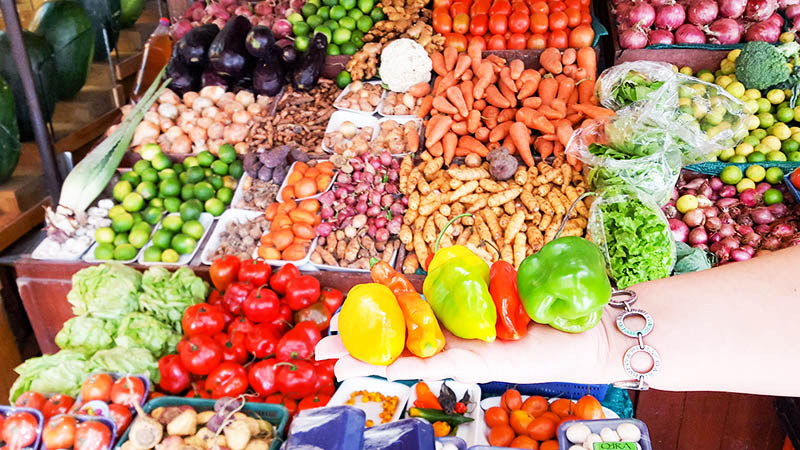 Ingredients in Peru
Ingredients in Peru
After know the tradtional Peruvian cuisine, you may wonder its history and evolution. Peru is the third largest country in South America, after Brazil and Argentina, with a variety of landscapes. Thanks to its diversity in landscape and climate (Peru has 28 diverse microclimates), Peru has a great variety of fresh local produce in different regions, most of which are essential ingredients of the local people. This can be seen in the traditional regional dishes that have been passed down from generation to generation.
The Coastal Region
Because of the Humboldt Current (also Peru Current) which is responsible for 18 to 20 percent of the marine fish catch in the world, this area is known for its remarkable diversity of seafood, including sardines, anchovies, mackerel, hake, and squid. The national dish of Peru, ceviche (marinated raw fish), finds its origins here. Other popular seafood dishes include chupe de camarones (shrimp cioppino).
The Andes Area
As you explore higher to the valleys and plains of the Andes, you'll find that food there is mainly based on corn and potatoes, two key energy sources of the Inca Empire (1438–1533). Potatoes were first developed here about 8,000 years ago, and Peru has an amazing number of different varieties of potatoes (some estimate over 4,000 varieties), many of which are still used in cooking today. For instance, papas a la huancaína, which is boiled potatoes ladled with spicy, creamy sauce, is a noteworthy dish in the bustling Huancayo that sits in the central highlands.
Meats from indigenous animals such as alpacas and cuy (guinea pigs) are the main source of protein for the local people, but there are also sheep, cattle and swine that were introduced by the Spanish. Thus, the quintessential cuisine of the highlands is pachamanca, a traditional dish made from meat, herbs, and vegetables cooked underground with heated stones.
 All Kinds of Potatoes in a Local Market, Peru
All Kinds of Potatoes in a Local Market, Peru
The Amazon Rainforest
Food in the Amazon region is prepared with the local produce from freshwater fish to tropical fruits and vegetables. You'll marvel at its colorful array of bizarre food that is not seen anywhere else in the world. The most unmissable specialty is the delicious juanes, steamed rice, and fish wrapped in a jungle leaf, which is easily taken away for a long riverboat ride. Parrilladas de la selva, barbecued rainforest meats marinated in Brazil nut sauce, is also a hallmark dish in this region. Belén Mercado, a traditional market in Iquitos which is the largest metropolis in the Peruvian Amazon, is a popular place to sample bizarre food including meaty Amazon worms, simmered sabalo fish intestines and fried leafcutter ants.
Influences on the Flavors of Peruvian Food
Rooted in the indigenous traditions, Peruvian cuisine has gained influences from other cultures including European, African, and Asian over the past several hundred years. The result is a fusion cuisine that reflects the nation's multicultural history.
Spanish Influence
The Spanish conquered the Inca Empire in the 16th century. They brought cows, pigs and goats to this ancient land where people traditionally gained much of their meat and protein from the cuy (guinea pig). They also introduced cabbage, peaches, apples, garlic and onions.
African Influence
The Spanish brought African slaves who accounted for the use of grains, yams, peanuts and sugarcane in Peru. African families had to rely on unused meat, entrails, and leftovers that the Spanish wouldn't eat. They used a lot of spices to make them more appetizing. If you want to get a taste of Afro-Peruvian food, tacu tacu is the one you should try. It is leftover beans and rice spiced with hot pepper and garlic, often served with pork, beef or an egg.
Chinese Influence
In the 19th century, a wave of Chinese laborers came to Peru. These immigrants brought soy sauce, rice and different cooking techniques, which created a blend of cuisines called chifa (derived from Mandarin "chi-fan", meaning "to eat rice"). The Peruvian ingredients combined with Chinese cooking techniques have generated a unique dining experience that is popular throughout the country. (Lima alone has thousands of chifa restaurants.) A typical example is kamlu wantan, crispy fried wontons served with pork and vegetables. It is a must-eat if you visit Lima.
Japanese Influence
The Japanese arrived in Peru in the late 19th century and created what is now called Nikkei cuisine. The biggest influence the Japanese have on the Peruvian cuisine is the preparation of seafood, which has been elevated to an art form. For example, ceviche, Peru's most iconic dish, uses cubed morsels of fresh fish such as calamari or scallops marinated in lime, chilies, and onion. Tiradito, a dish of raw fish, is prepared by using sashimi-style seafood bathed in a piquant sauce of lime, ginger and aji amarillo.
Start Your Trip of Peruvian Food With Odynovo
These are just 7 of the best Peruvian dishes you can expect to have on your trip. They may not be your cup of tea, but still, they're worth trying as they are so essential to the Peruvian culinary culture and could be part of your memorable travel experience. Remember that anytime you want to explore Peru or other popular destinations in South America, Asia, Africa, and the Middle East, Odynovo can help you create a personalized trip, meeting all your needs and requirements.
Related Posts You May Like
What Our Clients Say
Explore the latest verified reviews of Odynovo's travel services on Tripadvisor, Google, Trustpilot, Product Review and more trusted platforms.

